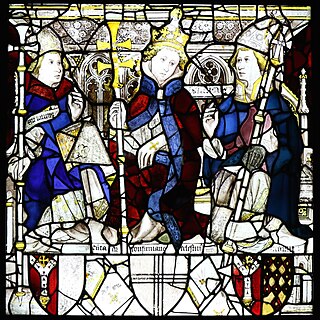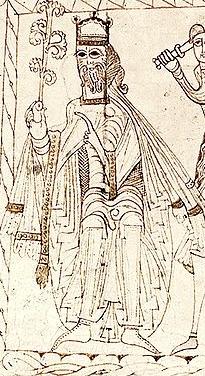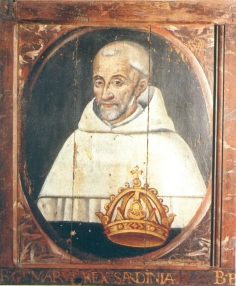Guido Pisano (died 1149) was a prelate and diplomat from Pisa. He probably belonged to the family of the counts of Caprona, and was promoted to the College of Cardinals and appointed to the deaconry of Santi Cosma e Damiano by Pope Innocent II on 4 March 1132. [1]
Between 10 and 11 December 1146 he was made Papal chancellor by the Pisan Pope Eugene III. [2] He was widely travelled, intervening in Spain, Portugal, France and Germany, and well-connected, to Wibald, to Anselm of Havelberg and to a succession of popes as well as several emperors and kings.
Guido served as a Papal legate to the Spaniards on three occasions. His first visit probably took place in 1133–34, his second in 1135–37 and his third and final in 1143. During the first he went to León (before August 1134), there to either preside over a synod or attend the royal court, to resolve in favour of Bernardo of Compostela a dispute with his archbishop, Diego Gelmírez, and to confirm the election of Berengar as Bishop of Salamanca, also against Diego's wishes. [2] [3] During the second he presided over a synod in Burgos, which granted an indulgence to the Confraternity of Belchite, and on 26 November 1143 during the third he held a council at Girona, where Count Raymond Berengar IV of Barcelona granted of fifth of the territory he had conquered from the Moors to the Knights Templar. [4] On his way through southern France on his first legation, he resolved in favour of the abbey of Saint-Thibéry a dispute over the church of Bessan with the monastery of La Chaise-Dieu. [3]
Guido had returned to Rome from his first Spanish expedition by December 1134. In 1135 he attended the council of Pisa, and then, with Bernard of Clairvaux and Geoffrey of Chartres, led an embassy to Milan to reconcile the revolting populace, which had declared for the Antipope Anacletus II and deposed Bishop Anselmo della Pusterla, with Innocent II. [2] [4] In June 1139 Guido was again in France as legate, holding a council at Uzès, where he resolved a dispute between the church of Lyons and the abbey of Cluny about which know nothing, and also revised his decision on the matter Bessan, forcing Saint-Thibéry to make an annual payment to La Chaise-Dieu as compensation. [3]
Guido returned to Rome by mid-November 1139, and he was still there in 1141, when the Papal curia deposed in absentia Abbot Ariulf of Saint-Riquier from the monastery of Oudenburg. [3] He joined the curia in June 1145, before he was made chancellor. In April 1146 he left the curia to help prepare the regency of Germany during the absence of Conrad III, who was about to leave on the Second Crusade. [4]
Either on 20 April (Easter), at Bamberg, or else on 23 April, at an imperial diet held in Nuremberg, he had a personal audience with Conrad. [3] At the end of the month he met Wibald, a friend with whom he had corresponded by letters for over twenty years, in Würzburg. [3] Guido joined Pope Eugene when the latter took ship from Pisa to France in 1147, there to hold several reforming councils and encourage the Second Crusade. Guido was with the Papal entourage when it entered Trier on 30 November. They returned to Rome in April 1148. [3]
Guido last subscribes to a document dated 16 May 1149, and his successor, Boso, was cardinal-deacon in November. The Gesta Adalberonis records that he was "a very wise man and notably eloquent" (virum prudentissimum et breviloquio notabilem) and Otto of Freising singles him out: "many great and learned men [come] out of the Roman part of the Church, one of whom was Guido the Pisan, who was a cardinal and chancellor of [the Roman] court" (ex parte Romanae ecclesiae viros magnos et claros, quorum unus Guido Pisanus, eiusdem curiae cardinalis et cancellarius erat). [3]

Pope Celestine II, born Guido di Castello, was head of the Catholic Church and ruler of the Papal States from 26 September 1143 to his death in 1144.
Pope Gregory VIII, born Alberto di Morra, was head of the Catholic Church and ruler of the Papal States for two months in 1187. Becoming Pope after a long diplomatic career as Apostolic Chancellor, he was notable in his brief reign for reconciling the Papacy with the estranged Holy Roman Empire and for initiating the Third Crusade.

Alfonso VII, called the Emperor, became the King of Galicia in 1111 and King of León and Castile in 1126. Alfonso, born Alfonso Raimúndez, first used the title Emperor of All Spain, alongside his mother Urraca, once she vested him with the direct rule of Toledo in 1116. Alfonso later held another investiture in 1135 in a grand ceremony reasserting his claims to the imperial title. He was the son of Urraca of León and Raymond of Burgundy, the first of the House of Ivrea to rule in the Iberian peninsula.

The Western Schism, also known as the Papal Schism, the Great Occidental Schism, or the Schism of 1378, was a split within the Catholic Church lasting from 1378 to 1417 in which bishops residing in Rome and Avignon both claimed to be the true pope, and were joined by a third line of Pisan claimants in 1409. The schism was driven by personalities and political allegiances, with the Avignon papacy being closely associated with the French monarchy.
The Apostolic Chancery was a dicastery of the Roman Curia at the service of the Pope. The principal and presiding official was the chancellor of the Holy Roman Church who was always the cardinal-priest of the Basilica di San Lorenzo in Damaso. The principal function of the office was to collect money to maintain the Papal army and to produce documents and correspondence for the Pope. Pope Pius VII reformed the office when Emperor Napoleon I of France obviated the need for Papal armies. In the early 20th century the office collected money for missionary work. Pope Paul VI abolished the Apostolic Chancellary on 27 February 1973, transferring its functions to the Secretariat of State.

Gonario II was the giudice of the Sardinian kingdom of Logudoro from the death of his father in 1128 until his own abdication in 1154. He was a son of Constantine I and Marcusa de Gunale. He was born between 1113 and 1114 according to later sources and the Camaldolese church of S. Trinità di Saccargia was founded in his name by his parents on 16 December 1112, though it was not consecrated until 5 October 1116.
Uberto Lanfranchi was the Cardinal-deacon of Santa Maria in Via Lata, then the Cardinal-priest of San Clemente, and finally the Archbishop of Pisa.
Boso was an Italian prelate and Cardinal of the Roman Catholic church.

The Archdiocese of Pisa is a Latin Church metropolitan see of the Catholic Church in Pisa, Italy. It was founded in the 4th century and elevated to the dignity of an archdiocese on 21 April 1092 by Pope Urban II. The seat of the bishop is the cathedral of the Assumption in the Piazza del Duomo.
Theodwin was a German cardinal and papal legate of the 12th century.
John of Crema was an Italian papal legate and cardinal. He was a close supporter of Pope Callistus II.
Guido de Summa was an Italian Cardinal.

The 1143 papal election followed the death of Pope Innocent II and resulted in the election of Pope Celestine II.
Landulf was the bishop of Pisa from the spring of 1077 until his death. His election marked a return to canon law in Pisa and he was consecrated by Pope Gregory VII. His election was also supported by Marchioness Matilda of Tuscany, who made a large donation to the canons of the cathedral during his episcopate.
Boso was a Roman Catholic cardinal, priest of Sant'Anastasia al Palatino (1116–1122) and bishop of Turin (1122–1126×28). He was a frequent apostolic legate, making four separate trips to Spain in this capacity. In Spain he proclaimed a crusade to re-conquer the Balearics and held several synods to establish the Gregorian reforms. In Turin, he introduced the truce of God to curb private warfare.
Deusdedit was the cardinal-priest of San Lorenzo in Damaso from 1116 until his death. He was named a cardinal by Pope Paschal II. Nothing is known of his life before he was a cardinal. He is not the canonist Balius Severinus Deusdedit, appointed cardinal priest of the Roman titular church Apostolorum in Eudóxia by Pope Gregory VII.
Pedro Helías was the Archbishop of Santiago de Compostela from 1143 until his death. Prior to becoming archbishop he was a canon of the cathedral of Saint James from 1102, serving as its dean in 1122–24.
Soffredo was an Italian cardinal. His name is also given as Soffredo Errico Gaetani, whilst his Christian name is also spelled Soffrido or Goffredo in some sources.

Pietro Diani was an Italian cardinal. The name "Diana" is incorrect; he signs himself Petrus Dianus.
The Council of Troyes was convened by Bernard of Clairvaux on 13 January 1129 in the city of Troyes. The council, largely attended by French clerics, was assembled to hear a petition by Hugues de Payens, head of the Knights Templar. Pope Honorius II did not attend the council, sending the papal legate, Matthew, cardinal-bishop of Albano. The council addressed issues concerning the Templar Order and a dispute between the bishop of Paris and king of France.
This page is based on this
Wikipedia article Text is available under the
CC BY-SA 4.0 license; additional terms may apply.
Images, videos and audio are available under their respective licenses.






